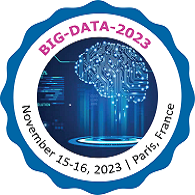Session And Tracks
Track 01: Big Data Infrastructure and Technologies:
Big Data infrastructure and technologies are a set of tools and frameworks that facilitate the storage, processing, and analysis of large and complex datasets. This technology has evolved significantly in recent years to cope with the growing volume, velocity, and variety of data. Some of the key components of big data infrastructure include distributed computing frameworks like Apache Hadoop and Apache Spark, cloud computing platforms like Amazon Web Services (AWS) and Microsoft Azure, and NoSQL databases like MongoDB and Cassandra. The use of big data infrastructure and technologies has become increasingly important in various industries as organizations strive to make data-driven decisions and gain insights from their data.
However, with the increased use of big data, there are also ethical and privacy concerns that must be addressed. The use of personal data raises important ethical questions regarding data privacy and security, and organizations must ensure that they adhere to ethical standards and regulations to avoid potential legal consequences. In conclusion, big data infrastructure and technologies offer organizations the ability to store, manage, and analyze vast amounts of data, but the responsible use of this technology requires careful consideration of ethical and privacy concerns.
• Analytics extracts insights from data using statistical and computational techniques.
• Data Visualization communicates insights through visual representations of data.
• New tools and technologies handle large and complex data sets.
• Key components include data preparation, exploratory data analysis, statistical modelling, and interactive visualization.
• Applications include business, healthcare, finance, and government.
• Helps organizations make data-driven decisions and communicate findings effectively.
• Ethical and privacy concerns are important considerations.
• Organizations must use data responsibly and address privacy concerns.
Track 02: Machine Learning and AI:
Machine learning and Artificial Intelligence (AI) are two closely related fields that involve the development of algorithms and models that enable computers to learn and perform tasks that would typically require human intelligence. ML is a subset of AI that focuses on developing algorithms that allow computers to learn from data and improve their performance on specific tasks over time. AI, on the other hand, encompasses a broader range of technologies and techniques that enable machines to perform human-like tasks such as decision-making, natural language processing, and computer vision.
Some of the key applications of ML and AI include image and speech recognition, natural language processing, predictive analytics, and autonomous systems. These technologies have the potential to transform a wide range of industries, including healthcare, finance, transportation, and manufacturing.
However, the use of ML and AI also raises important ethical and societal issues, including concerns about bias and discrimination, privacy, and the impact of automation on the workforce. As these technologies continue to advance and become more widely used, it is essential to ensure that they are developed and used in a responsible and ethical manner.
Track 03: Analytics and Data Visualization:
Analytics and Data Visualization refer to the process of analysing and visualizing data to gain insights and communicate findings. Analytics involves the use of statistical and computational techniques to extract insights from data, while data visualization involves the creation of visual representations of data to communicate these insights effectively.
The field of analytics and data visualization has evolved significantly in recent years, with new tools and technologies emerging to handle the increasing volume and complexity of data. Some of the key components of analytics and data visualization include data preparation and cleaning, exploratory data analysis, statistical modelling, and interactive visualization.
These technologies have significant applications in a wide range of fields, including business, healthcare, finance, and government. By providing a more intuitive way of understanding data, analytics and data visualization can help organizations make data-driven decisions and communicate findings more effectively.
However, the use of analytics and data visualization also raises important ethical and privacy concerns. As organizations collect and analyze increasing amounts of data, it is important to ensure that this data is used responsibly and ethically, and that privacy concerns are appropriately addressed
Track 04: Data Mining and Text Mining:
Data Mining and Text Mining are techniques used to extract insights from large datasets. Data Mining involves the process of discovering patterns and relationships in large datasets through the use of statistical and computational techniques. Text Mining, on the other hand, involves the extraction of meaningful insights and knowledge from unstructured text data, such as emails, documents, and social media posts.
Data Mining and Text Mining are widely used in various industries, including healthcare, finance, retail, and telecommunications. Some of the key applications of these techniques include customer segmentation, fraud detection, sentiment analysis, and recommendation systems.
The use of Data Mining and Text Mining has also raised concerns about privacy and data security. As organizations collect and analyze large amounts of data, it is essential to ensure that privacy and security concerns are addressed and that data is used responsibly.
Here are some bullet points summarizing Data Mining and Text Mining:
• Data Mining extracts insights from large datasets through statistical and computational techniques.
• Text Mining extracts insights and knowledge from unstructured text data.
• Key applications include customer segmentation, fraud detection, sentiment analysis, and recommendation systems.
• Widely used in various industries, including healthcare, finance, retail, and telecommunications.
• Concerns about privacy and data security must be addressed.
• Organizations must use data responsibly and adhere to privacy regulations.
Track 5: High Performance Computing:
High Performance Computing (HPC) refers to the use of advanced computing systems and techniques to solve complex computational problems. HPC systems typically consist of clusters of powerful computers that work together to execute large-scale computations quickly and efficiently.
HPC has many applications across a wide range of industries, including scientific research, engineering, finance, and healthcare. Some of the key applications of HPC include climate modeling, drug discovery, financial modelling, and genomics.
HPC also presents significant technical challenges, including the need to design algorithms that can scale to thousands or millions of processing cores, as well as the need to manage and distribute data efficiently across multiple nodes.
Overall, HPC enables researchers and organizations to tackle complex problems that were previously infeasible, and it is expected to play an increasingly important role in driving scientific and technological progress in the future.
Track 6: Applications of Big Data and Analytics:
Big Data and Analytics have numerous applications across various industries. These technologies enable organizations to make data-driven decisions and gain insights from large datasets. Some of the key applications of Big Data and Analytics include:
Healthcare: Analytics can be used to analyse patient data, optimize hospital operations, and develop personalized treatment plans.
Retail: Big Data and Analytics can be used to improve supply chain management, predict customer behaviour, and optimize pricing strategies.
Finance: Analytics can be used to detect fraud, manage risk, and improve investment decisions.
Manufacturing: Big Data and Analytics can be used to improve quality control, optimize production processes, and predict equipment failures.
Marketing: Big Data and Analytics can be used to develop targeted marketing campaigns, understand customer preferences, and optimize customer engagement.
Transportation: Analytics can be used to optimize logistics operations, improve safety, and reduce fuel consumption.
Government: Big Data and Analytics can be used to improve public safety, predict and prevent crime, and optimize public services.
Education: Analytics can be used to improve student outcomes, optimize educational resources, and personalize learning experiences.
Overall, Big Data and Analytics have the potential to transform various industries by providing insights and driving data-driven decision making.
Track 07: Computer Science Fundamentals:
Computer Science Fundamentals are the foundational concepts and principles that underpin the field of computer science. These include algorithms, data structures, programming languages, operating systems, computer architecture, networks, databases, and software engineering.
Algorithms are step-by-step procedures for solving problems, while data structures are ways of organizing and storing data for efficient access and manipulation. Programming languages are used to write computer programs and communicate with computers, while operating systems manage computer hardware and provide services for other software. Computer architecture refers to the design of computer systems, including processors, memory, and input/output devices.
Networks enable computers to communicate with each other and share resources, while databases are used to store and manage large amounts of structured data. Finally, software engineering is the process of designing, developing, testing, and maintaining software.
Overall, Computer Science Fundamentals are essential for anyone seeking to enter the field of computer science or develop computer-based solutions for various applications. These concepts provide the building blocks for understanding and developing computer systems and software.
Track 08: Data Privacy and Security:
Data Privacy and Security are critical aspects of managing data in modern technology. Here is a summary with some important points:
• Data privacy: Data privacy refers to the protection of personal information from unauthorized access, use, or disclosure. This includes the collection, storage, and use of personal data, such as names, addresses, and financial information.
• Data security: Data security refers to the protection of data from unauthorized access, use, or disclosure. This includes measures to prevent hacking, data breaches, and other malicious attacks.
• Encryption: Encryption is a technique used to protect data by encoding it so that it can only be accessed by authorized users. Encryption is often used for sensitive data, such as financial information or personal data.
• Authentication: Authentication is the process of verifying the identity of a user, device, or application. This includes the use of usernames, passwords, and other security measures to ensure that only authorized users can access data.
• Access controls: Access controls are security measures that restrict access to data based on user roles and permissions. This includes limiting access to sensitive data to only authorized users.
• Compliance: Compliance with data privacy and security regulations, such as GDPR, HIPAA, and PCI-DSS, is essential to avoid legal and financial penalties.
• Cyber security: Cyber security measures, such as firewalls, intrusion detection systems, and antivirus software, are important for protecting data from cyber threats.
Overall, Data Privacy and Security are critical aspects of managing data in modern technology. Encryption, authentication, access controls, compliance, and cyber security measures are all important components of an effective data privacy and security strategy. Organizations must prioritize data privacy and security to protect sensitive information and maintain the trust of their customers.
Track 09: Data Science for Social Good:
Data Science for Social Good is a field that aims to use data science techniques and tools to address social challenges and improve public welfare. This involves collaborating with government agencies, non-profit organizations, and social enterprises to analyse large and complex datasets and develop data-driven solutions. Key considerations for Data Science for Social Good projects include ethical and legal considerations, stakeholder engagement, and expertise in statistical analysis, machine learning, and data visualization. Successful projects have the potential to make a significant impact on society, such as reducing recidivism rates and improving access to healthcare in underserved communities.
• Data science for social good aims to leverage data and technology to address pressing social challenges, such as poverty, health care, education, and environmental issues.
• Data scientists working in this field often collaborate with government agencies, non-profit organizations, and social enterprises to analyse data and develop data-driven solutions.
• Data science for social good projects often involve working with large and complex datasets, and require expertise in statistical analysis, machine learning, and data visualization.
• Data science for social good projects must consider ethical and legal considerations, such as privacy concerns and data protection regulations.
• Examples of data science for social good projects include predicting and preventing child maltreatment, reducing recidivism rates in the criminal justice system, and improving access to health care in underserved communities.
Track 10: Real-Time and Stream Data Processing:
Real-time and stream data processing are essential for businesses that need to quickly and accurately process large amounts of data. Real-time data processing enables businesses to monitor and respond to events as they happen, while stream data processing allows for the analysis of data from multiple sources in real-time. However, real-time and stream data processing come with challenges, such as the need for high-speed data processing, data quality and consistency, and security and privacy concerns. To overcome these challenges, businesses can use stream processing engines, real-time analytics platforms, and machine learning models. With the right infrastructure and tools, businesses can make informed decisions quickly and stay competitive in today's fast-paced digital landscape.
Real-time and stream data processing are essential for businesses that need to make quick and informed decisions.
Real-time data processing enables businesses to monitor and respond to events as they happen.
Stream data processing allows for the analysis of data from multiple sources in real-time.
Real-time and stream data processing come with challenges such as high-speed data processing, data quality and consistency, and security and privacy concerns.
To overcome these challenges, businesses can use stream processing engines, real-time analytics platforms, and machine learning models.
The right infrastructure and tools enable businesses to make informed decisions quickly and stay competitive in the fast-paced digital landscape.
Track 11: Big Data Governance and Management:
Big Data Governance and Management are critical components of any data-driven business. Effective governance ensures that data is managed consistently and transparently, while management ensures that data is easily accessible and usable. Big Data Governance and Management involve various processes, including data acquisition, storage, processing, and analysis. The challenges associated with Big Data Governance and Management include data quality and consistency, data privacy and security, and compliance with regulatory requirements. To address these challenges, businesses can implement data governance frameworks, adopt data quality management practices, and leverage data analytics tools. Effective Big Data Governance and Management can help businesses gain valuable insights and make informed decisions based on trustworthy and reliable data.
Big Data Governance and Management are critical for effective data-driven decision-making.
Governance ensures that data is managed consistently and transparently, while management ensures that data is accessible and usable.
Processes involved in Big Data Governance and Management include data acquisition, storage, processing, and analysis.
Challenges include data quality and consistency, privacy and security, and regulatory compliance.
Solutions include data governance frameworks, data quality management, and data analytics tools.
Effective Big Data Governance and Management enable businesses to gain valuable insights and make informed decisions based on trustworthy and reliable data.
Track 12: Data Ethics and Bias:
Data Ethics and Bias are critical components of any data-driven business. Ethical considerations ensure that data is collected, managed, and used in ways that are fair, transparent, and respectful of privacy. Bias can arise in data analysis when data is collected, sampled, or analysed in ways that disproportionately favor or disadvantage certain groups. The challenges associated with Data Ethics and Bias include identifying and mitigating biases in data analysis and developing ethical frameworks that ensure responsible data use. To address these challenges, businesses can adopt ethical data practices, implement data bias detection and mitigation tools, and prioritize diversity and inclusivity in data collection and analysis. Effective Data Ethics and Bias management can help businesses build trust with stakeholders and ensure that data is used in ways that are responsible, fair, and ethical.
Data Ethics and Bias are essential components of any data-driven business.
Ethical considerations ensure that data is collected, managed, and used in ways that are fair, transparent, and respectful of privacy.
Bias can arise in data analysis when data is collected, sampled, or analysed in ways that disproportionately favour or disadvantage certain groups.
Challenges include identifying and mitigating biases in data analysis and developing ethical frameworks for responsible data use.
Solutions include adopting ethical data practices, implementing data bias detection and mitigation tools, and prioritizing diversity and inclusivity in data collection and analysis.
Effective Data Ethics and Bias management can help businesses build trust with stakeholders and ensure that data is used in ways that are responsible, fair, and ethical.
Track 13: Big Data Applications in Industry:
Big Data applications in Industry refer to the use of large volumes of structured and unstructured data to derive insights that can drive business growth and profitability. In Industry, Big Data applications are used for a wide range of purposes, including predictive maintenance, supply chain optimization, customer analytics, and fraud detection. These applications enable businesses to make informed decisions based on real-time data, improve operational efficiency, and enhance customer experience. The challenges associated with Big Data applications in Industry include data quality and consistency, data privacy and security, and the need for specialized skills and expertise. To address these challenges, businesses can leverage Big Data analytics tools, adopt data governance frameworks, and invest in employee training and development. Effective use of Big Data applications in Industry can help businesses stay competitive, innovate faster, and achieve strategic goals.
Big Data applications in Industry use large volumes of structured and unstructured data to derive insights for business growth and profitability.
Applications include predictive maintenance, supply chain optimization, customer analytics, and fraud detection.
Benefits include real-time data-driven decision-making, improved operational efficiency, and enhanced customer experience.
Challenges include data quality and consistency, data privacy and security, and the need for specialized skills and expertise.
Solutions include Big Data analytics tools, data governance frameworks, and employee training and development.
Effective use of Big Data applications in Industry can help businesses stay competitive, innovate faster, and achieve strategic goals.
Track 14: Data Science Tools and Platforms:
Data Science Tools and Platforms are software applications that enable data scientists to collect, process, and analyse large volumes of data. These tools and platforms provide a range of functionalities, including data ingestion, data cleaning, data analysis, data visualization, and machine learning. The most popular Data Science Tools and Platforms include programming languages like Python and R, data storage and processing technologies like Hadoop and Spark, cloud-based platforms like Amazon Web Services (AWS) and Microsoft Azure, and machine learning libraries like TensorFlow and Scikit-learn. The challenges associated with Data Science Tools and Platforms include the need for specialized skills and expertise, integration with existing systems, and ensuring data privacy and security. To address these challenges, businesses can invest in employee training and development, adopt agile development methodologies, and implement data governance frameworks. Effective use of Data Science Tools and Platforms can help businesses unlock the value of their data, gain insights into customer behaviour, and drive innovation.
Track 15: Data Science Education and Workforce Development:
Data Science Education and Workforce Development refer to efforts aimed at building a skilled workforce that can meet the growing demand for data-driven insights. These efforts include educational programs, training initiatives, and professional development opportunities. The goal of Data Science Education and Workforce Development is to equip individuals with the technical and analytical skills required to collect, process, and analyse large volumes of data. The challenges associated with Data Science Education and Workforce Development include the rapid pace of technological change, the need for specialized skills and expertise, and the difficulty of keeping up with evolving industry standards. To address these challenges, educational institutions and businesses can invest in curriculum development, offer professional development opportunities, and foster a culture of continuous learning. Effective Data Science Education and Workforce Development can help individuals build rewarding careers, businesses stay competitive, and society harness the full potential of data-driven innovation.


















